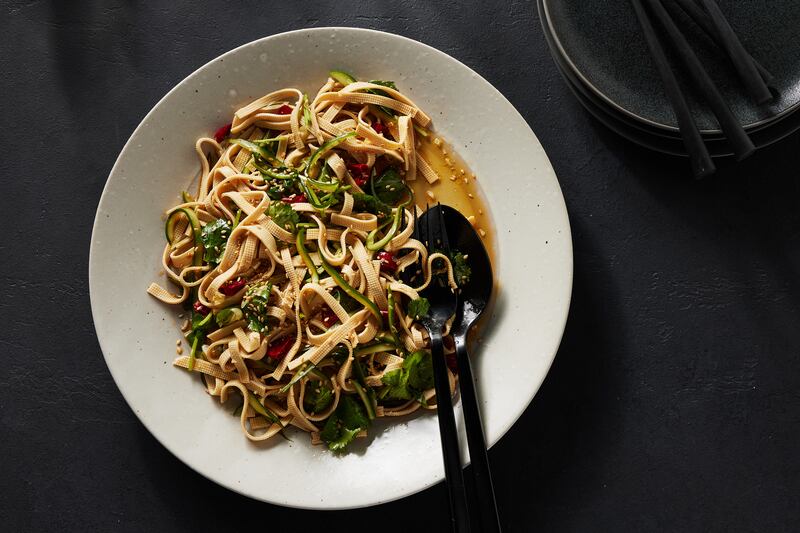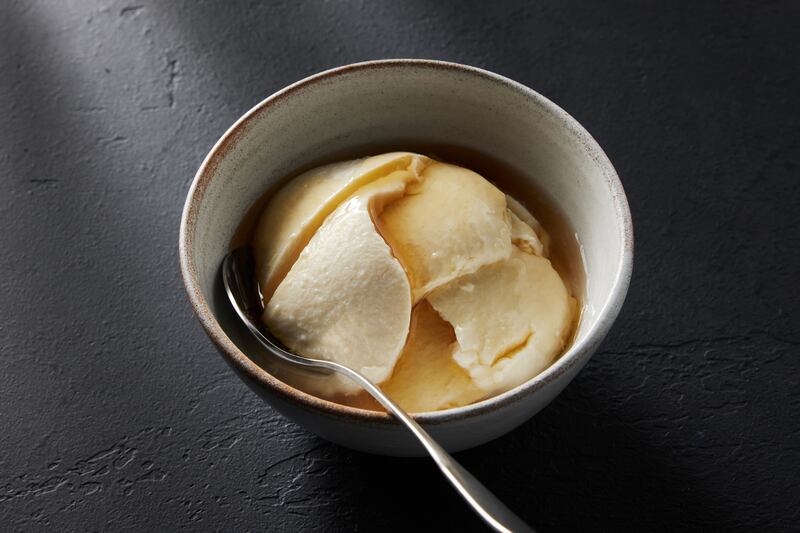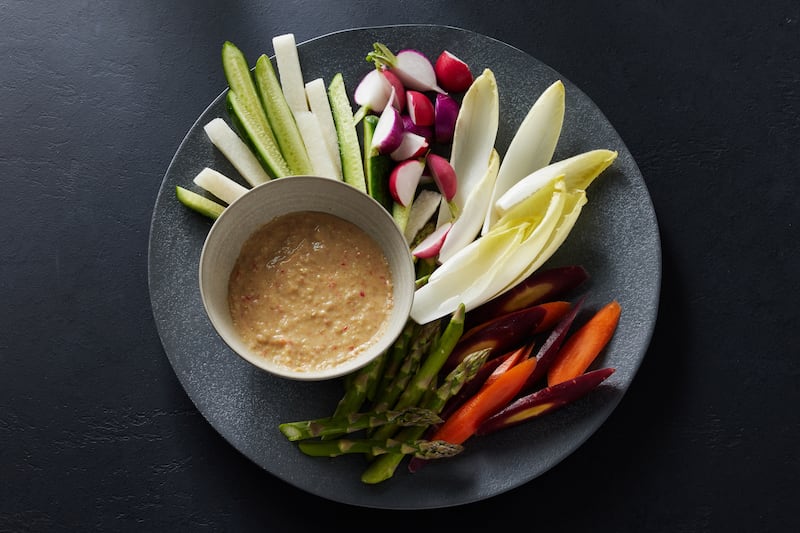These are good times for tofu lovers, with an expanding market and growing options. The rising popularity of plant-based cooking is also seeding a groundswell of interest in celebrating tofu’s power and potential. If you’re new to tofu – or even if you’re not – you may not know the full depth and breadth of styles, and what to use when. Don’t let that hinder you. In fact, you can consider tofu – a staple of cooking in China, where it was invented 2,000 years ago, and throughout Asia – as falling into three broad categories: basic, chewy and intensely flavoured.
Tofu’s wide range
Making tofu is a simple yet nuanced craft: High-protein food-grade soybeans are carefully selected and soaked, made into soy milk and coagulated with a salt or edible organic acid, or both. The resulting semi-solid curds and clear whey are further manipulated for different kinds of tofu.
As a general rule, your needs and where you shop will determine the tofu you select. Most recipes call for basic tofu, sold in tubs or vacuum-sealed packages. Its neutral character and porous texture make it a kind of culinary chameleon, allowing it to easily take on flavours, whether in earthy braises or zippy stir-fries, or served crisped and served with a dipping sauce.
Texture is determined by if and how the curds are pressed. Basic tofu options include silken, medium, medium-firm, firm, extra-firm and super-firm. Many dishes involve slicing, cubing and mashing tofu, but, depending on its density, it can be scooped, crumbled and even grated.
Dancing with the Stars: ‘I’ve had the best time of my life. I feel super fit,’ chef Kevin Dundon says as he is voted off show
Oscars 2025 red carpet: Ariana Grande sets the standard while Timothée Chalamet stood out in ‘Kerrygold’ yellow
Róisín Ingle puts a Thermomix to the test: ‘I am a convert but there’s one enormous catch’
Life without children: ‘I’d want the investment my mother had, but I don’t have it in me. I don’t have the grá for it’
While mainstream supermarkets typically carry only silken and perhaps firmer types, Asian grocers may offer the full spectrum, with medium and medium-firm tofu as the go-to for many cooks when preparing classics, such as mapo tofu and agedashi tofu.
Pressed (baked) tofu, tofu sheets and fried tofu are all styles of chewy tofu. Their low-water content makes them especially convenient, requiring minimal prep or manipulation. Hannah Che, author of The Vegan Chinese Kitchen (Random House, 2022) uses pressed tofu sheets, cut into ribbons, in her liángbàn gāndòufusī, a shredded tofu salad.

Some dishes specify a certain kind of chewy tofu – think fried tofu pouches for inari sushi – but when you are experimenting, just cut the tofu and add it to soups, hot pots, rolls, salads and sandwiches. It is no-fail tofu.
Pressed tofu, which is sold unseasoned (plain) or flavoured (labelled braised or baked), is available at some mainstream grocers, Asian markets and tofu shops.
Fried tofu belongs to the realm of Asian grocers. Mostly sold at Chinese markets, nubby tofu sheets are worth seeking out. (Despite its name, tofu skin, or yuba, is only a film of soy milk, so it is not technically tofu, which involves a coagulant.)
Intensely flavoured tofu includes stinky tofu, a deep-fried favourite in Taiwan. But what gets more action – especially as an umami-packed seasoning – are white and red fermented tofu (aka fermented bean curd), which are sold in jars at Chinese and Vietnamese markets in the condiments section. Much like cheese, they vary in fabulous funk. White fermented tofu can be fragrant and winey, rich from sesame oil or spicy from chile. It commonly seasons stir-fried greens but can be combined with lemon grass and lime for a vibrant Vietnamese sauce to serve with crudités. Sweet, salty and aromatic, red fermented tofu contains red yeast rice and is often used for Cantonese char siu pork.
How to use it
Tofu’s beauty lies in its cross-cultural applications. For example, if ricotta is unavailable for lasagne, use mashed medium-firm tofu. Medium-firm or firm tofu can take the place of mozzarella in a vegan Caprese salad. In a stir-fry, partly or fully replace the meat with sliced pressed (baked) tofu. To use it in moist, low-meat burgers, add one part mashed firm tofu to two parts meat. Bear in mind that tofu is fully cooked, so you can always taste it to ensure the flavours work before adding it to raw protein.
Wherever your tofu journey leads you, consider it as having the Chinese notion of bāoróng de gèxìng, a very generous nature.

Dòuhuā (Silken tofu with ginger syrup)
Recipe by Andrea Nguyen.
A mainstay at dim sum restaurants and a popular street food in China and Southeast Asia, this cosy tofu pudding is as simple as scooping tofu and pouring gingery syrup on top. Also known as dòufuhuā in Mandarin (“bean curd flower” or “tofu flower”), dòuhuā is typically made with freshly made tender tofu, but packaged silken tofu makes the treat extra doable at home. For wonderful, custardy results, select silken tofu that’s been moulded in its tub. (Block tofu sitting in a moat of water tends to be too firm.) Using a broad, shallow spoon to scoop out the tofu creates thin, wide shards, yielding maximum surface area exposure to the zippy ginger syrup. Warming the tofu in the microwave reveals its tender richness to mimic the texture of fresh dòuhuā. Old-school renditions feature just tofu and ginger syrup, but modern ones might include a wide range of add-ins similar to those offered for shaved-ice or boba treats. Canned mandarin orange segments would add vibrant contrast.
Ingredients
- 1 chubby (4cm) piece fresh ginger, peeled, very thinly sliced and smashed
- 73g firmly packed light brown sugar
- 60ml agave syrup or mild honey
- 1 star anise (optional)
- 450g silken tofu
Method:
1. In a small saucepan, combine the ginger, brown sugar, agave, star anise (if using) and 120ml of water. Bring to a boil over medium-high heat, then lower the heat to around medium-low to briskly simmer for about six minutes, until fragrant and slightly thickened. (Coat the back of a metal spoon in the mixture, then drag your fingertip across it and a faint line should hold.) Turn off the heat and let sit for about 15 minutes, uncovered, to intensify flavour and thicken to a syrupy consistency. Pour through a mesh strainer set over a small bowl, press on the solids, then discard the solids. You should have a generous 125ml ginger syrup. (The syrup keeps, refrigerated, for up to five days.)
2. Before assembling, gather six small, microwave-safe bowls (ideally what you’d serve rice or ice cream in). Pour out any excess water from each tofu tub. Wield a broad, shallow metal serving spoon in a horizontal motion to scoop up large, very shallow pieces of the tofu, dividing them among the bowls. (It’s normal for the pieces to be irregular in shape and size.)
3. Heat the bowls of tofu in the microwave, fitting as many in as possible and zapping in 20-second intervals until slightly warmed through. Liquid inevitably accumulates and you may pour it out to prevent it from diluting the syrup, or just allow its delicate tang to add to the overall flavour.
4. Drizzle each serving with about 1½ tablespoons of ginger syrup. Enjoy with a spoon.
Liangban Gandoufusi (shredded tofu salad)
Recipe from Hannah Che; adapted by Andrea Nguyen.
Take a stack of sturdy, nutty-tasting fresh tofu sheets (gāndòufu in Mandarin) and cut them up into noodle-like ribbons to combine with cucumber, cilantro and a spicy, garlicky sauce. The stunningly good, satisfying result is a northeastern Chinese treat, a favourite of cookbook author Hannah Che. This recipe was adapted from her debut, The Vegan Chinese Kitchen (Random House, 2022). Look for vacuum-sealed packages of tan-coloured, nubby gāndòufu, often labelled as soy tofu sheet in the refrigerated tofu section in Chinese markets. Enjoy this salad with dumplings or a cosy soup. Change things up by stuffing it into a baguette or featuring it in lettuce wraps.
Ingredients
- For the salad:
- 230g pressed tofu sheets (gandoufu)
- 1 small Persian cucumber, halved, seeded and julienned
- 1 large handful fresh coriander, stems and leaves cut into 2.5cm segments
- 26g thinly sliced spring onion whites
- 4 or 5 mild dried red chillies, such as Tianjin, snipped into 2.5cm segments, seeds shaken out
- 3 garlic cloves, minced
- For the dressing:
- 1½ tbsp soy sauce
- 1½ tbsp unseasoned rice vinegar, plus more to taste
- 1½ tbsp chilli oil
- 1½ tsp toasted sesame oil
- ¾ tsp sea salt
- ¾ tsp granulated sugar, plus more to taste
- 3 tbsp neutral oil (such as rapeseed)
- Toasted sesame seeds, for garnish
Method:
1. Cut the tofu sheets into 10cm-wide strips. (If they’re the standard 20cm-square sheets, just cut them in half.) Next, cut those strips crosswise into narrower, 600mm-wide pieces that resemble short noodles; to efficiently slice the strips, roll two sheets up at a time like a cinnamon roll before cutting. Scrappy bits are fine.
2. Bring a medium or large saucepan of water to a rolling boil. Toss in the tofu noodles and blanch for about two minutes, or just until the water returns to a boil. Drain, dump the noodles back into the pot, add cold water to cover and then drain again. (This will improve the tofu’s texture and reduce its beany flavours.) Let sit for a few minutes to cool, then in batches, use your hands to squeeze out water from the noodles.
3. Put the cucumber and coriander in a large bowl, then add the tofu noodles, spreading them out flat. Atop the tofu noodles, toward the centre, add the aromatics: spring onion whites, dried chillies and garlic. In a small bowl, stir together the soy sauce, vinegar, chilli oil, sesame oil, salt and sugar; set the dressing aside.
4. In a small saucepan, heat the neutral oil over medium until nearly smoking, about two minutes. Pour the hot oil over the aromatics to release their fragrance with a loud sizzle. Pour the dressing on to the tofu noodles then toss well to combine. Taste and adjust the seasoning as desired, adding more vinegar for acidity, sugar for sweetness, and salt as needed. Transfer to a serving bowl or deep plate (including the dressing for flavour), sprinkle with sesame seeds and serve immediately.
Tip: To use tassel-like “soy tofu slices,” cut the pieces crosswise into 7 to 10cm-long strips. With the remaining ends (the tops of the tassels), stand each on its uncut side and slice crosswise to match the other noodles. Use your fingers to quickly separate them before using.

Crudités with lemon grass-fermented tofu dip
Recipe by Andrea Nguyen
For rau củ sống chấm chao, a Vietnamese take on crudités, serve raw, seasonal veggies with a tangy, spicy, umami-rich sauce featuring chao (fermented tofu), a wondrous ingredient that’s akin to creamy, winey cheese. Fermented tofu typically punches up stir-fried greens or a bowl of porridge, but Vietnamese cooks love to let it shine as a sauce. The dynamite nước chấm Chao (fermented tofu dipping sauce) could be paired with grilled goat or lamb, but it’s fantastic as a dip. For this recipe, from my cookbook Ever-Green Vietnamese (Ten Speed Press, 2023), choose at least three vegetables from the crudité options. The sesame seed addition isn’t standard, but adds body and richness to the sauce, uniting the ingredients. Make a double batch of sauce, if you like, so you have extra to dress grilled romaine; top it with fried shallots for a summertime salad.
Ingredients
- For the dip:
- 20g fermented white tofu, preferably without chilli, plus brine as needed
- 1½ tbsp agave syrup, mild honey or granulated sugar
- 1½ tbsp fresh lime juice, plus more as needed
- 1½ tbsp minced fresh lemongrass
- 2 to 3 Thai or small serrano chiles, finely chopped
- 2 tbsp toasted white sesame seeds (optional, to thicken and enrich)
- 1 to 3 tsp neutral oil (such as rapeseed)
- For the crudités:
- 1 or 2 small watermelon radishes, or a half or whole bunch red radishes, sliced thinly or cut into wedges
- 1 or 2 medium carrots, scrubbed or peeled then sliced on the diagonal
- 225g to 450g jicama, peeled and cut into chubby, 7cm sticks
- ½ small cucumber, thickly sliced or cut into chubby 7cm sticks
- 1 or 2 small handfuls raw asparagus or green beans, trimmed and cut into 7cm lengths
- 1 or 2 small endives, leaves separated
Method:
1. Prepare the dip: In a small bowl, using a fork or the back of a spoon, mash the tofu (expect lingering solids). Stir in the agave and lime juice, then add tofu brine by the teaspoon to achieve a pleasant salty-sour-sweet-winey balance. Stir in the lemon grass and chillies. (You can make the sauce up to five days ahead and refrigerate in an airtight container; return to room temperature to serve.)
2. If using the sesame seeds, use a mortar and pestle to stir, grind and pound them into a fragrant, finely textured mixture. (Alternatively, use a small food processor or an electric spice grinder.) Scrape and stir into the dip. Let the dip develop flavour for about 15 minutes before tasting, then add enough of the neutral oil to soften, lime juice to brighten, plus additional brine to intensify.
3. Prepare the crudités: If the veggies are limp and need perking up, fill a large bowl with water and ice, then submerge them in the icy bath for a few minutes to crisp; drain and pat dry. Arrange all the crudités on a platter. Transfer the dip to a small bowl and set in the centre or on the side of the platter. Invite diners to dip and eat.
Tip: You can find fermented tofu in the condiment aisle at Chinese or Vietnamese markets. Look for jars of “fermented bean curd” containing tofu cubes in brine; brands such as Cache’ de Chef, Hwang Ryh Shiang and Wei-Chuan are consistently good. Instead of fermented tofu, you can substitute 2½ tablespoons of shiro (white) miso mixed with 1½ tablespoons water to make a less edgy lemon grass-miso dip. – This article originally appeared in The New York Times
2023 The New York Times Company













